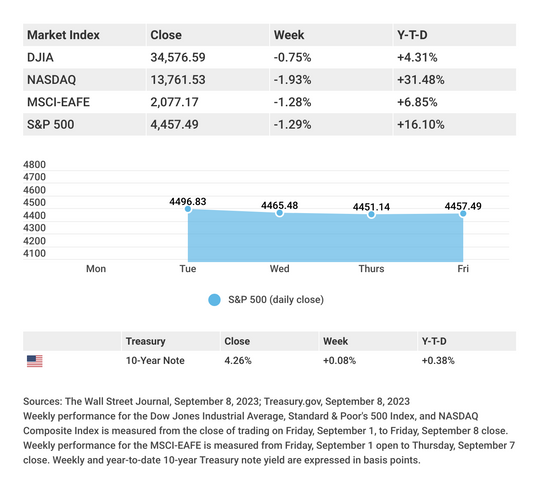Weekly Market Insights: Stocks End Summer with Gloomy News
|
Rising bond yields and fears of a government shutdown hammered stocks last week, with technology shares bearing the brunt of the retreat. The Dow Jones Industrial Average lost 1.89%, while the Standard & Poor’s 500 dropped 2.93%. The Nasdaq Composite index tumbled 3.62% for the week. The MSCI EAFE index, which tracks developed overseas stock markets, fell 1.77%.1,2,3 |
 |
 |
Stocks Sell OffInvestor sentiment took a decidedly negative turn last week when investors were caught off-guard by the Fed signaling another potential rate hike this year, upending hopes that the Fed might finish its current rate-hike cycle. Stocks declined sharply following the Federal Open Market Committee (FOMC) announcement and continued to fall the following day as bond yields spiked. The 10-year Treasury yield hit 4.48% on Thursday, touching its highest point in more than 15 years.4 Stocks also reacted to news that the House of Representatives went into recess on Thursday, increasing the prospect of a government shutdown. The sell-off cooled on Friday, adding only incrementally to the week’s accumulated losses. Fed Signals Rate HikeAs expected, the Fed held interest rates steady but surprised many investors by signaling another rate hike before year-end and suggesting that rates may need to remain high through 2024. In his post-announcement press conference, Fed Chair Powell remarked the inflation battle would continue, and upcoming economic data would inform the FOMC’s future rate hike decision. In their economic projections, 12 of 19 Fed officials expect to raise rates once more this year. (The FOMC meets again on October 31-November 1, and in December.) The Fed also lowered their unemployment projection from their June estimate and revised their projection for annual core inflation to 3.7% in the fourth quarter, down from June’s 3.9% forecast.5 This Week: Key Economic DataTuesday: Consumer Confidence. New Home Sales. Wednesday: Durable Goods Orders. Thursday: Jobless Claims. Gross Domestic Product (GDP). Friday: Personal Income and Outlays. Source: Econoday, September 22, 2023 This Week: Companies Reporting EarningsTuesday: Costco Wholesale Corporation (COST) Wednesday: Micron Technology, Inc. (MU) Thursday: Nike, Inc. (NKE) Source: Zacks, September 22, 2023 |
 |
|
“If you have passion, a chip on the shoulder, a sense of humor, and you can explain what you do very well, it doesn’t matter if you’re a plumber or a singer or a politician. If you have those four things, you are interesting.” – Larry King |
 |
Think about Credits and Deductions Now to Prepare for FilingHere are a few facts about credits and deductions that can help you with year-round tax preparation:
Taxpayers can subtract tax credits from the total amount of tax they owe. To claim a credit, taxpayers should keep records showing their eligibility. Some major tax credits include the Child Tax Credit and the Child and Dependent Care Credit, the American Opportunity Credit or Lifetime Learning Credit, and the Earned Income Tax Credit. *This information is not intended to substitute for specific individualized tax advice. We suggest you discuss your specific tax issues with a qualified tax professional. Tip adapted from IRS.gov6 |
 |
Macro Dieting is a New Way to Approach Calorie CountingMacro dieting goes a step further than just basic calorie counting. Instead of counting just the number of calories, you count the macronutrients, including proteins, carbs, and fats. How much of each macronutrient you need depends on your body type, goal, lifestyle, and activity level. Rather than depriving your body of nutrients, you are instead focusing on meals that give your body the nutrients it needs to be more efficient. To start a macro diet, you must first calculate how many grams of each macro you should eat. A rough breakdown is 50-25-25, meaning 50% of your calories come from carbs, 25% from protein, and 25% from fat. But this breakdown will depend on your goals. For example, if you focus on strength training, you should eat more protein. Naturally, you will want to discuss any significant changes to your diet with your medical professionals. Tip adapted from Eating Well7 |
 |
|
Hannah went to a local hardware store to buy some small items. One would cost $2, two would run $4, but buying 122 would only cost $6. She purchased 122, yet she was not buying in bulk; she could carry what she bought with one hand. What did she purchase?
Last week’s riddle: How can you turn the Roman numeral for 9 (IX) into 6 by merely drawing a single, continuous line? Answer: Draw the letter S to the left of the Roman numeral, and you will get “six”. |
 |
 |
|
A surface level sunrise view of Amsterdam at dawn |
|
|
Footnotes and Sources
2. The Wall Street Journal, September 22, 2023 3. The Wall Street Journal, September 22, 2023 4. CNBC, September 21, 2023 5. The Wall Street Journal, September 23, 2023 6. IRS.gov, January 31, 2023 7. EatingWell.com, January 4, 2023 |









